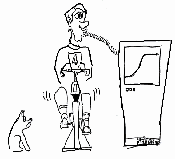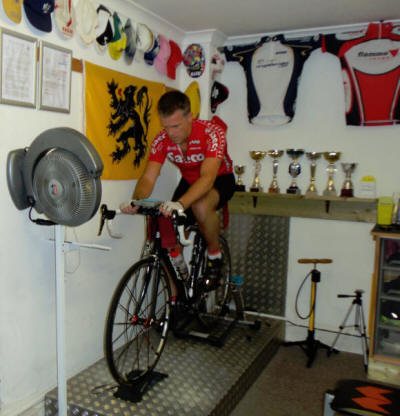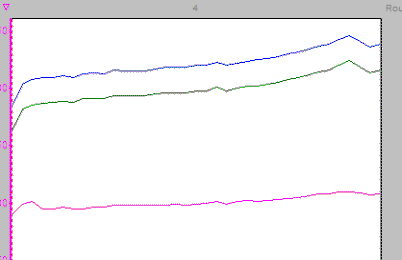The Self Test

Not everyone can or wants to, or can visit us to undertake a fitness test, or as we now like to call them, Performance Evaluations.
But that doesn't mean you can't carrying out one yourself, in the "comfort" of your own home.
All you need is a turbo a stopwatch and according to your technical availabilities, one or more of the following:
Dog's are optional. Ours always wants to get in on the act as cyclists always have food with them. At least dog's aren't judgmental. They're always happy to see you and wag their tail at the end of your exertions, which always makes you feel as though you did well!▼ heart monitor ▼ rear wheel speedo in kilometres ▼ power meter
Setting Yourself Up
Before you turn a pedal in anger, you need to ensure that you
eliminate all variables from your calculations. The accuracy of
your results are determined by your levels of attention to detail before
the ride. So give these following paragraphs your full
attention...
Tyre Pressures, when I say pressures I mean pressure. We're only interested in the back wheel. Set it to 100 psi every single time you get on the turbo. Doesn't matter what you ride on the road, make it 100 psi when you're on the rack.
Gearing, make sure that when you run subsequent tests, against which you'll compare your initial results, that you have the same block on the back wheel and/or the same chainring on the front. Don't think this is being too picky, because I've seen it done and the results are not always comparable.
The bike, obviously, is important also. Try to take subsequent comparator tests on the same bike as your initial test, Road bike, winter bike or TT bike, it doesn't matter which as long as it's the same one every time you are comparing against a baseline.
If, during the season, you wish to measure your TT power then of course you'll need to take a baseline test on that bike before measuring improvement. Don't do the first one on a winter hack, then the second on the TT bike and expect to get meaningful results.
Turbo resistance of the wheel against the roller is also highly important. Note the number of turns on the knob from initial tyre contact until the wheel stops spinning under load. Or do a run down test by getting up to 35 kph, holding it for five seconds, then stop pedalling and measure the time it takes the wheel to come to a complete stop. Make a note of it, then make sure all other tests are run at the same roller resistance.
Test Duration, is determined by the outcome you are trying to achieve, the discipline for which you are training, and the physiological response you are trying to measure.
If you are a road racer, a Puncheur, short-sharp climber type or a breakaway specialist, you'll want to try the get in there and hang on, wVO2max Test.
If you're of the TT persuasion, are in to long 10k climbs, or are the type that brings the breakaways back, then the more endurance based 20 minute Test will be your torture of choice
To get an all round picture of your physiological performance markers why not do both?
Try the 20 minute test on Tuesday, a 20 minute recovery spin on Wednesday, and a 6 minute
Test on Thursday.
They must be done in this order. If you do the shorter, more intense,
effort first, you'll compromise the longer one. Incomplete picture; close but no cigar!

To Action
Almost. It would be a shame if you went through all the
rigmarole of the above then didn't pay attention to your warm up
routine. Again, find a routine that works for you and stick to it.
Read this factsheet for suggestions on
how to structure a workable routine.
The test most carried out by ourselves is the dreaded six minute stinger, that is the wVO2max Test.
This little leg stretcher is used to determine an athlete's minimal wattage at which maximal aerobic capacity is attained. It tells you their sustained wattage output at their maximum oxygen consumption, which is indicated by the term, wVO2max.
The other alternative, is the longer, less anaerobically or neuro-muscularly influenced, head-banger that is the 20 minute Lactate Accumulator.Let the pain begin
It's not big, but it is clever, but its only for the committed or those with time on their hands. You get a little more accurate information but at a much higher, time and physiological cost. Save it for the intervals.
Okay, we're off. Everything is set; you've followed the list above and you've warmed up correctly. Stop the bike and compose yourself. Let your heart rate come back to a "nice" level, take a sip of your drink, then start the stop watch and start pedalling towards the flying start.
Once you've started the stopwatch, build up slowly and take a minute to get to 80% of your expected six minute effort. Don't go too hard too soon, the test hasn't started yet.
As the watch heads towards completing 60 seconds, gently build up to hit the 61st second with a "sustainable effort" flying start. If you haven't got a fancy turbo trainer for downloading your results, hit the trip counter on your speedo.
Ride as smoothly as you can, constantly evaluating your position and ability to get to the end of the six, or twenty, minutes with nothing left in the tank. You don't want to end up like example two, below.
In the following profiles
the colour codes used are:
Green ~ Power;
Brown ~ Heart Rate
Pink ~ Cadence;
Blue ~ Speed.
Example one is a perfect ride, almost. They dipped with about 15 seconds to go. But at least they knew they had nothing left.

Whereas this rider went out to break the world six minute record and fell Icarus-like, back to earth. Not a good day at the office!

Notice the heart rate (brown line) through the above shenanigans. A massive drop off in power (green) but no change in heart rate. A valuable lesson learned in the art of pacing. Look at this graph and understand the ramifications before undertaking your own test. This is the most important piece of info on this page!
Study these two graphs and visualise your effort to make it more like the first than the second.
As you get to the end of your test, hit the trip counter on your speedo and take at least 5-10 minutes to cool down. Job done!
What Now? If you have a sexy downloadable turbo programme, or power meter, then you look for your average power output.
If it was a 6 minute effort, that's your wVO2max; the power you put out at your maximum oxygen consumption.
Generally, the 6 minute test extrapolates out to a 105% of your predicted 20 minute effort. The 20 minute test extrapolates out to 105% of your 60 minute effort, or if you're using power, your FTP.
If you haven't got all that power gizmo, then check the trip on your speedo and find the average speed, or distance covered, for your test period. You can't do loads of calculations or extrapolations from this info, but it does give you an idea of how far, or how fast you've travelled during your test.
Save the information somewhere safe, go away do your training for a couple of months, then come back and repeat the test, following your previous preparations to the letter.
The difference in speed, distance or power output is your improvement. It's that simple.
The Message
It works for me and it may work for you. But unless you take a test you may never find out.
Click here to
read the VO2max factsheet for further info.
I can guarantee this is the best cycling investment you'll ever make. What have you got to lose?
If you don't want to, or can't visit us, then carry out your own test by following these instruction.
Just don't try it on the road. It won't work. Trust me, and watch out for dogs...









